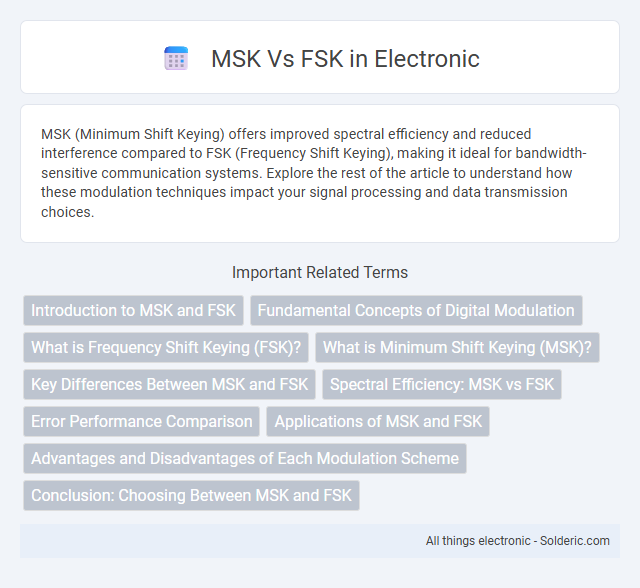MSK (Minimum Shift Keying) offers improved spectral efficiency and reduced interference compared to FSK (Frequency Shift Keying), making it ideal for bandwidth-sensitive communication systems. Explore the rest of the article to understand how these modulation techniques impact your signal processing and data transmission choices.
Comparison Table
| Feature | MSK (Minimum Shift Keying) | FSK (Frequency Shift Keying) |
|---|---|---|
| Modulation Type | Continuous phase frequency modulation | Discrete frequency modulation |
| Frequency Separation | Minimum frequency difference (0.5 x bit rate) | Variable, typically greater than MSK |
| Spectral Efficiency | High | Lower compared to MSK |
| Bandwidth | Compact, narrow bandwidth | Wider than MSK |
| Phase Continuity | Continuous phase, reduces signal interference | Phase discontinuities present |
| Bit Error Rate (BER) | Lower BER under AWGN | Higher BER compared to MSK |
| Implementation Complexity | More complex | Simple, easier to implement |
| Applications | Wireless communication, satellite links | Low-speed modem, telemetry systems |
Introduction to MSK and FSK
MSK (Minimum Shift Keying) is a continuous phase frequency shift keying technique that uses minimal frequency deviation to achieve efficient spectral usage and reduced interference. FSK (Frequency Shift Keying) represents digital data by shifting between two or more distinct frequencies, commonly used for low-complexity and robust communication systems. Understanding the differences between MSK and FSK helps optimize your digital modulation approach for bandwidth efficiency and signal clarity.
Fundamental Concepts of Digital Modulation
MSK (Minimum Shift Keying) and FSK (Frequency Shift Keying) are digital modulation techniques that encode information by varying the frequency of a carrier signal. FSK uses discrete frequency shifts to represent binary data, with each frequency corresponding to a different binary state, while MSK is a special form of continuous-phase FSK with a minimum frequency spacing, ensuring a constant envelope and reduced spectral side lobes. The fundamental concept of MSK lies in its phase continuity and minimal frequency deviation, which results in improved spectral efficiency and lower error rates compared to conventional FSK.
What is Frequency Shift Keying (FSK)?
Frequency Shift Keying (FSK) is a digital modulation technique where the frequency of a carrier wave is varied to represent binary data, making it essential for wireless communication systems. Unlike Minimum Shift Keying (MSK), which is a type of continuous-phase frequency shift keying that minimizes spectral bandwidth, FSK uses distinct, discrete frequencies for different binary states, enhancing signal robustness. Understanding how FSK operates can help you optimize data transmission and reduce interference in communication networks.
What is Minimum Shift Keying (MSK)?
Minimum Shift Keying (MSK) is a type of continuous-phase frequency shift keying modulation that minimizes the frequency spacing between symbols to achieve orthogonality, resulting in efficient spectrum utilization. Its modulation index of 0.5 ensures a constant envelope and reduced signal sidelobes, which improves power efficiency and reduces interference in communication systems. Understanding MSK can enhance your system design by providing better performance in bandwidth-constrained and noisy wireless environments compared to traditional FSK.
Key Differences Between MSK and FSK
MSK (Minimum Shift Keying) uses continuous phase modulation with a frequency separation of half the bit rate, resulting in a constant envelope and spectral efficiency. FSK (Frequency Shift Keying) employs discrete frequency changes with a frequency deviation larger than MSK, leading to simpler implementation but higher bandwidth consumption. MSK offers better performance in terms of error rates and spectral usage, while FSK is often favored for its ease of demodulation and implementation.
Spectral Efficiency: MSK vs FSK
MSK (Minimum Shift Keying) offers higher spectral efficiency compared to traditional FSK (Frequency Shift Keying) due to its continuous phase modulation and optimized frequency separation. The spectral compactness in MSK reduces bandwidth usage by minimizing sideband power, enhancing data transmission rates within limited bandwidth environments. Your communication system benefits from improved performance and reduced interference when utilizing MSK over conventional FSK.
Error Performance Comparison
MSK (Minimum Shift Keying) offers superior error performance compared to FSK (Frequency Shift Keying) due to its continuous phase modulation and constant envelope properties, which result in lower bit error rates (BER) in noisy environments. MSK's spectral efficiency and reduced intersymbol interference enhance its robustness against fading and Gaussian noise, leading to improved signal reliability. By choosing MSK, your communication system benefits from enhanced error resilience and more efficient bandwidth usage compared to conventional FSK modulation schemes.
Applications of MSK and FSK
MSK (Minimum Shift Keying) is widely used in wireless communication systems such as GSM cellular networks and satellite transmissions due to its spectral efficiency and constant envelope properties, which enable robust performance in noisy environments. FSK (Frequency Shift Keying) finds applications in low-power radio devices, wireless remote controls, and telemetry systems because of its simplicity and ease of implementation in hardware. Choosing between MSK and FSK depends on your specific application requirements, including bandwidth efficiency, power consumption, and environmental conditions.
Advantages and Disadvantages of Each Modulation Scheme
MSK (Minimum Shift Keying) offers high spectral efficiency and constant envelope properties, which reduce signal distortion and improve power efficiency, making it ideal for wireless communication systems. FSK (Frequency Shift Keying) is simpler to implement and provides robustness against noise and interference but suffers from lower spectral efficiency and higher bandwidth requirements compared to MSK. MSK's main disadvantage is its complex demodulation process, while FSK's major drawback is susceptibility to frequency variations that can degrade performance in frequency-selective channels.
Conclusion: Choosing Between MSK and FSK
MSK offers better spectral efficiency and lower bit error rates compared to FSK, making it ideal for bandwidth-constrained applications requiring robust performance. FSK provides simpler implementation and greater noise immunity in certain environments, suitable for low-cost, low-power devices. The choice between MSK and FSK depends on specific system requirements like bandwidth availability, power constraints, and desired error performance.
MSK vs FSK Infographic

 solderic.com
solderic.com